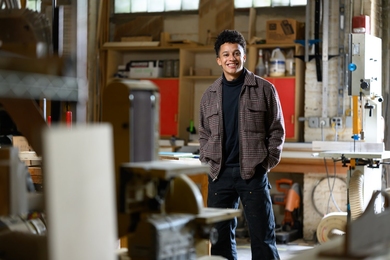As an undergraduate engineering student, Zach Hartwig was introduced to the methods, procedures and practices that form an engineer’s toolkit. But, he recalls, his real interest was in “the principles the tools were built on, the fundamental physics that lay behind them.” So he switched majors and became a physicist, spending the next few years working in particle physics before joining the MIT NSE doctoral program.
Working at NSE’s Plasma Science and Fusion Center (PSFC), Hartwig has led the development of a groundbreaking materials diagnostic system that will help advance nuclear fusion as a practical energy source. And in the process, he has cultivated his true passion — “a mixture of nuclear physics and materials science with a bit of engineering thrown in.”
The work exemplifies NSE's increasing focus on interdisciplinary projects that support worldwide development of commercial fusion power plants utilizing tokamak reactors, like PSFC’s Alcator C-Mod. Tokamaks have made huge strides in functionality, successfully using magnetic fields to confine plasmas where lighter elements fuse into heavier ones, as they do in the core of stars, at temperatures of up to 100 million degrees Celsius.
One important area of inquiry is the interaction between the confined plasma and the materials inside the tokamak's high-vacuum chamber. “The plasma and the chamber walls are a coupled system,” Hartwig explains. “C-Mod’s wall tiles and other plasma-facing components are made from robust refractory metals, like molybdenum, but we’re pushing their material limits by exposing them to enormous heat, charged-particle, and neutron fluxes that can cause severe surface modifications.”
Understanding how these components behave during ongoing reactor operation is intimately tied to several grand challenges still facing fusion — maintaining and controlling steady-state burning plasmas, mitigating deleterious effects of plasma-material interactions, and minimizing required maintenance. But until now, it has been effectively impossible to make routine, comprehensive measurements of plasma-facing materials in the hostile and inaccessible environment of a tokamak chamber.
Read the full article
Working at NSE’s Plasma Science and Fusion Center (PSFC), Hartwig has led the development of a groundbreaking materials diagnostic system that will help advance nuclear fusion as a practical energy source. And in the process, he has cultivated his true passion — “a mixture of nuclear physics and materials science with a bit of engineering thrown in.”
The work exemplifies NSE's increasing focus on interdisciplinary projects that support worldwide development of commercial fusion power plants utilizing tokamak reactors, like PSFC’s Alcator C-Mod. Tokamaks have made huge strides in functionality, successfully using magnetic fields to confine plasmas where lighter elements fuse into heavier ones, as they do in the core of stars, at temperatures of up to 100 million degrees Celsius.
One important area of inquiry is the interaction between the confined plasma and the materials inside the tokamak's high-vacuum chamber. “The plasma and the chamber walls are a coupled system,” Hartwig explains. “C-Mod’s wall tiles and other plasma-facing components are made from robust refractory metals, like molybdenum, but we’re pushing their material limits by exposing them to enormous heat, charged-particle, and neutron fluxes that can cause severe surface modifications.”
Understanding how these components behave during ongoing reactor operation is intimately tied to several grand challenges still facing fusion — maintaining and controlling steady-state burning plasmas, mitigating deleterious effects of plasma-material interactions, and minimizing required maintenance. But until now, it has been effectively impossible to make routine, comprehensive measurements of plasma-facing materials in the hostile and inaccessible environment of a tokamak chamber.
Read the full article






